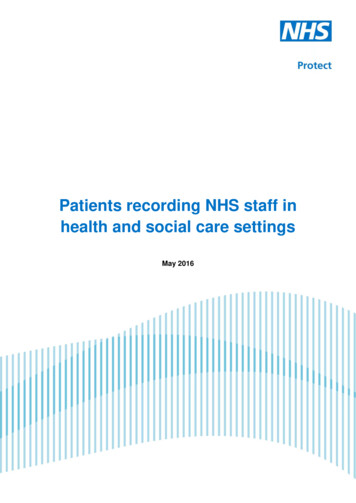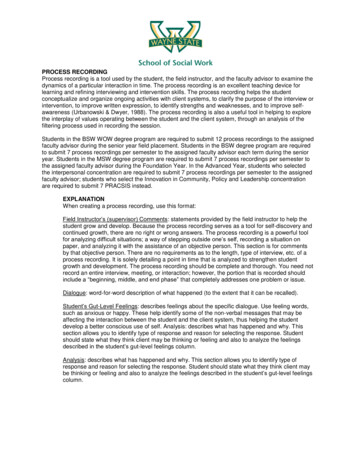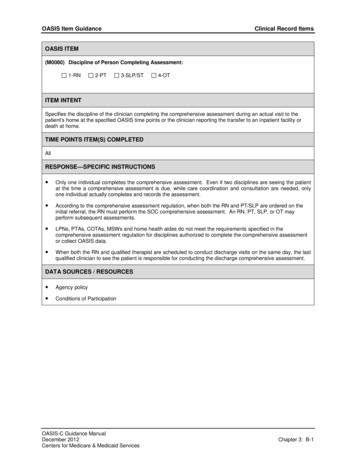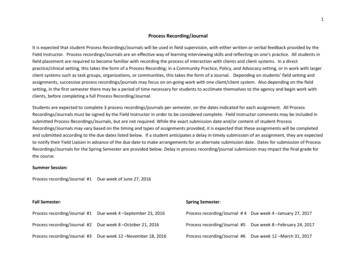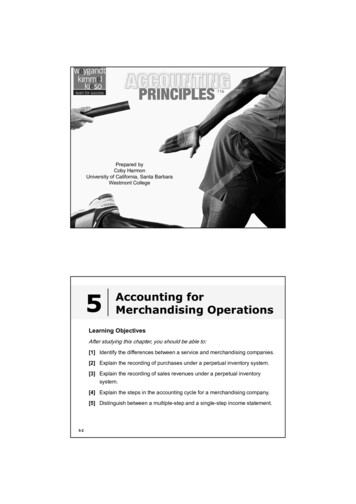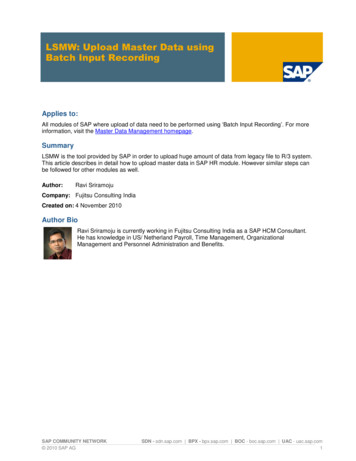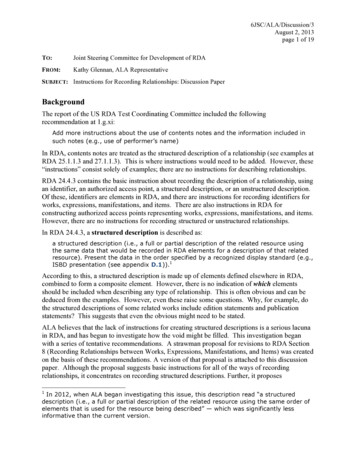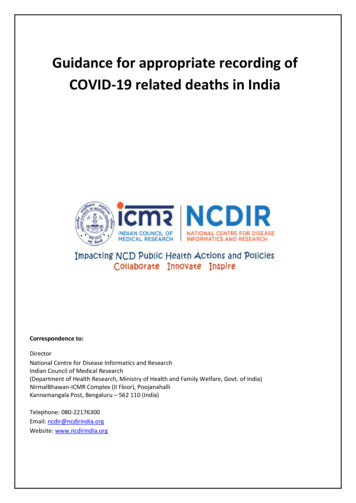
Transcription
Guidance for appropriate recording ofCOVID-19 related deaths in IndiaCorrespondence to:DirectorNational Centre for Disease Informatics and ResearchIndian Council of Medical Research(Department of Health Research, Ministry of Health and Family Welfare, Govt. of India)NirmalBhawan-ICMR Complex (II Floor), PoojanahalliKannamangala Post, Bengaluru – 562 110 (India)Telephone: 080-22176300Email: ncdir@ncdirindia.orgWebsite: www.ncdirindia.org
Table of ContentsSl No1SectionIntroductionPage No1-31.1What is Cause of Death?11.2How to record Cause of Death?11.3What is Underlying Cause of Death?1.4Public health significance of Cause of Death data2COVID-191-233-42.1COVID-19 pandemic and need for cause of death32.2COVID-19 as Underlying Cause of Death (UCOD)32.343.1ICD-10 Codes for COVID-19 provided by World HealthOrganization (WHO)Public health significance of recording cause of death inCOVID-19 pandemicCompleting Medical Certification of Cause of Death(MCCD) in COVID-19Mortality coding of COVID-19 with ICD-10 codes3.2Examples of underlying cause of death in COVID-195-63.3What to avoid as Cause of Death?7-83.4Other considerations in recording MCCD for COVID -1984ICMR - NCDIR e-Mortality software (e-Mor)95Additional Guides92.4344-84
1. Introduction1.1 What is Cause of Death?The cause of death (COD) is defined as “all those diseases, morbid conditions or abnormalities, injurieswhich either resulted in or contributed to death and the circumstances of the accident or violence whichproduced any such injuries.”(1)1.2 How to record Cause of Death?Medical Certificate of Cause of Death (MCCD) is the certificate issued by the attending medicalpractitioner who had treated the person during admission in a medical institution or in the last illness(prior to death) while taking treatment from a physician outside of a medical institution. Medicalcertification of cause of death is the process of recording and reporting death using standard Form 4(institutional deaths) and Form 4A (non-institutional deaths) as per the rules of the Registration of Birthsand Death Act, 1969. The MCCD form contains Part 1 to record the immediate and antecedent causes,and Part 2 to record the significant conditions that contributed to the death but were not part of thesequence of events leading to death.Image 1: Cause of Death section of Form 4/4A1.3 What is Underlying COD?Death often results from the combined effect of two or more independent or related conditions, that is,one condition may lead to another, which in turn leads to a third condition and so on. Where there is asequence, the disease or injury which initiated the sequence of events, called the underlying cause ofdeath is recorded and reported. It is:(a) The disease or injury which initiated the train of morbid events leading directly to death;Or(b) The circumstances of the accident or violence which produced the fatal injury.All the morbid conditions or injuries consequent to the underlying cause relating to death are termed asantecedent and immediate cause.1
The medical part of the certificate consists of two partsI. Sequence of events leading to death First line is the immediate cause of death – the condition / disease that directly led to death / thatpreceded death.The cause of death antecedent to immediate cause should be entered in line (b), and a cause furtherantecedent to this should be entered in line (c).Underlying cause of death is on the lowest line of part I – It is the disease or condition that started thesequence of events between normal health to immediate cause of death. Conditions if any, as aconsequence thereof will be entered above it in ascending causal order of sequence.How many cause of death can be entered in Part I?Only one cause is to be entered on each line of Part I. There may be many morbid events that happened,but the sequence of events that caused death should be sorted out, and one cause should be written oneach line of Part 1 so that there is a logical sequence of events leading to death.What if there is only one condition?The disease, injury or complication that immediately preceded death can be the only entry in the MCCDFORM if only one condition is present at death.What if there is only one condition antecedent to the immediate cause?The condition antecedent to the immediate cause should be entered in line (b). Line (c) should be keptblank.How to record time interval from onset of disease to death?The time interval between the presumed onset of the condition, not the diagnosis, and death should bereported. It is acceptable to approximate the intervals or use general terms, such as hours, days, weeks,or years.II. Other significant conditions that contributed to the deathAll other diseases or conditions believed to have unfavourably influenced the course of the disease leadingto death, but were not related to the disease or condition directly causing death.What should be entered in Part II - Other significant conditions?Any disease, abnormality, injury or late effects of poisoning, believed to have adversely affected thedeceased should be reported such as chronic conditions, and also information such as: Chronic Bronchitis /COPD/Asthma/ Tuberculosis Cancer –Primary / Metastatic cancer / On cancerdirected treatment /Old cancer - cured ortreated Cardiovascular disease- Hypertension /IHD/Coronary Heart Disease / heart failure Stroke / Neurological conditions like epilepsy,Parkinson’s disease, dementia, Alzheimer’sdisease Rheumatoid arthritis / Immune relatedconditions2 Use of alcohol and/or other substances. Tobacco use (smoking / smokeless) Recent pregnancy, if believed to have contributedto the death. Environmental factors-exposure to toxic fumes,history of working in specific industry,professional exposure to toxins, specific animals Late effects of injury, including head injurysequelae Any iatrogenic underlying cause Surgical information, if applicable
1.4 Public health significance of Cause of Death dataStating the sequence of morbid conditions in order, allows selection of the cause of death that isconsidered as “underlying” cause. It is the underlying cause of death that is coded with ICD -10 codes andis counted for statistical purposes.Robust cause of death information in a population is useful for understanding disease burden estimations,and explains trends in the health of populations. It is useful for evaluation and planning of health servicesand programmes. Good cause of mortality statistics also aids in identifying research questions of publichealth significance.2COVID-192.1 COVID-19 pandemic and need for cause of deathCOVID-19 is the infectious disease caused by the most recently discovered coronavirus (SARS- CoV- 2)from Wuhan, China, in December 2019. The COVID-19 disease outbreak was declared a Public HealthEmergency of International Concern (PHEIC) on 30 January 2020 by the World Health Organization, andlater on 11 March 2020 as a Global Pandemic. During such situations, mortality surveillance becomes avery important public health tool to assess the impact of the viral infection.2.2 COVID-19 as Underlying Cause of Death (UCOD)COVID-19 is reported to cause pneumonia / acute respiratory distress syndrome (ARDS) / cardiac injury /disseminated intravascular coagulation and so on. These may lead to death and may be recorded in line‘a’ or ‘b’. It is likely that COVID-19 is the underlying cause of death (UCOD) that lead to ARDS or Pneumoniain most of the deaths due to COVID-19 (test positive and symptoms positive). In these cases COVID-19must be captured in the last line / lowest line of Part 1 of MCCD form 4/4 A. Acute respiratory failure is amode of dying and it is prudent not to record it in line a/b/c.Patients may present with other pre-existing comorbid conditions such as chronic obstructive pulmonarydisease (COPD) or asthma, chronic bronchitis, ischemic heart disease, cancer and diabetes mellitus. Theseconditions increase the risk of developing respiratory infections, and may lead to complications and severedisease in a COVID-19 positive individual. These conditions are not considered as UCOD as they havedirectly not caused death due to COVID-19. Also a patient may have many co-morbid conditions, but onlythose that have contributed to death should be recorded in Part 2.2.3 ICD-10 Codes for COVID-19 provided by World Health OrganizationEmergency ICD-10 CodeU07.1U07.2Usage conditionsCOVID-19,virus identifiedCOVID-19, virus not identified,Clinically-epidemiologically diagnosed COVID-19Probable COVID-19Suspected COVID-193
2.4 Public health significance of recording cause of death in COVID-19 pandemicCOVID-19 is a new disease and is a pandemic affecting all communities and countries. It’s clinicalpresentation ranges from mild to severe, and fatality depends on the severity of the illness, associated comorbid conditions and age of patients. Patterns of disease and patterns of death can come from onlystandardised recording of clinical disease history and cause of death, and therefore epidemiologicalsurveillance of disease and death are important. Robust data is needed from every district and state inIndia to measure the public health impact of COVID 19 and to plan for timely health interventions andprotect communities. At the same time, other health conditions affecting populations need to be alsomonitored so that the health system is prepared for responding to the needs of the population.3Completing Medical Certification of Cause of Death (MCCD) in COVID-193.1 Mortality coding of COVID-19 with ICD-10 codesThe ICD-10 codes presently recommended by WHO for mortality coding are:TestSymptoms of COVID-19 veNone vePresent veTest NegativeDiagnosisCodeConfirmed COVID-19Confirmed COVID-19documented as UCODU07.1Present with comorbid conditionsConfirmed COVID-19like heart disease, asthma, COPD,documented as UCODType 2 diabetesPresentClinically –Epidemiologicallydiagnosed COVID -19Test awaitedPresentSuspected COVID-19Test inconclusivePresentProbable COVID-19U07.1U07.1U07.23.2 Examples of underlying cause of death in COVID-19Some examples are provided to help physicians’ record cause of death in COVID-19Example 1 : 40 year old male diagnosed with COVID-19CAUSE OF DEATHPart IImmediate CauseState the disease, injury orcomplication which causeddeath, not the mode ofdying such as heart failure,asthenia, etca) Respiratory acidosis4Interval betweenonset and deathapprox2 daysFor statisticaluse
Antecedent causeMorbid conditions, if any,giving rise to the abovecause stating underlyingconditions last.Part IIOther significantconditions contributing tothe death but not relatedto the disease or conditioncausing it.b) Acute respiratory distresssyndrome (ARDS)3 daysc) COVID-197 daysU07.1 . . . .Example 2 : 60 year old male, father of COVID-19 patient and a known diabetes individual presentedwith Influenza like illness (ILI) and died, test for COVID-19 not availableCAUSE OF DEATHPart IInterval betweenFor statisticalonset and deathuseapproxImmediate CauseState the disease, injury orcomplication which causeda) Acute respiratory distress1 daydeath, not the mode ofsyndrome (ARDS)dying such as heart failure,asthenia, etcAntecedent causeb) Influenza like illness4 daysMorbid conditions, if any,giving rise to the abovec) COVID-19 suspect4 daysU07.2cause stating underlyingconditions last.Part IIDiabetes15 yearsOther significant conditions contributing to the death but not relatedto the disease or conditioncausing it.Example 3 : 50 year old female completed chemotherapy for Breast cancer admitted withbreathlessness and developed shock and diedCAUSE OF DEATHPart IInterval betweenFor statisticalonset and deathuseapproxImmediate CauseState the disease, injury orcomplication which causeda) Disseminated Intravascular2 daysdeath, not the mode ofCoagulation ( DIC)dying such as heart failure,asthenia, etc5
Antecedent causeMorbid conditions, if any,giving rise to the abovecause stating underlyingconditions last.Part IIOther significantconditions contributing tothe death but not relatedto the disease or conditioncausing it.b) Pneumonia5 daysc) COVID-195 daysBreast CancerU07.16 months . . .Example 4 76 year old male with Ischemic heart disease developed fever and breathlessness two daysago, and was admitted and died in 24 hours, first test was inconclusiveCAUSE OF DEATHPart IInterval betweenFor statisticalonset and deathuseapproxImmediate CauseState the disease, injury orcomplication which causeda) Acute cardiac injury1 daydeath, not the mode ofdying such as heart failure,asthenia, etcAntecedent causeb) Probable COVID-192 daysU07.2Morbid conditions, if any,giving rise to the abovecause stating underlyingconditions last.Part IIIschemic heart diseaseOther significant conditions contributing to . .the death but not related . .to the disease or conditioncausing it.3.3 What to avoid as Cause of Death? Avoid Mode of Dying as Cause of Death – Mode of dying merely tells you that death has occurred andis not specifically related to the disease process.Mode of dyingRespiratory ArrestEmaciationVasovagal attackAsphyxiaExhaustionCardiac arrestAstheniaHeart FailureHeart attackBrain failureHepatic/Liver failureHepatic failureCachexiaHepatorenal failureLiver FailureCardiac Arrest/HeartKidney failure/RenalCardio respiratory failureAttackfailureMultiorgan/System failure6
Cardio RespiratoryArrestComaDebilityRespiratory arrest/FailureShockSyncopeUraemiaVagal inhibitionRespiratory FailureCardio Pulmonary failure Avoid abbreviations and short forms like ARDS, COPD, SARI.IncorrectARDSCOPDSARSCRFMIADMSRTICorrectAcute respiratory distress syndromeChronic obstructive pulmonary diseaseSevere Acute Respiratory illnessCRF could be Cardio respiratory failure or Chronic Renal failureMyocardial Infarction / Mitral IncompetenceAcute Diarrhoea / Alzheimer s DementiaMitral Stenosis / Multiple SclerosisRespiratory Tract Infection / Reproductive Tract Infection Though COVID-19 (Corona virus disease -19) is an abbreviation, it has been specified by the WHO andis an acceptable term to be used as UCOD. Avoid vague terms or ambiguity –Sometimes it is difficult to provide a simple description of cause of death when there are no medicalrecords or a doctor is seeing the patient in a critical condition for the first time or the doctor is not thetreating physician.IncorrectIrrelevant talking and feverishnessVery poor nourishmentLess healthy at birth Avoid short forms / incomplete description –IncorrectCa BrAc. InfarctSev Mal CorrectDelirium due to feverSevere MalnutritionLow birth weight / Congenital AnomalyCorrectCancer Breast / Cancer BrainAcute Myocardial Infarction / Acute Cerebral InfarctionSevere Malaria / Severe MalnutritionAvoid symptoms / signsIncorrectCorrectJaundiceFeverChest pain HepatitisInfectionAnginaAvoid terms such as senescence, old age, senility, infirmity, and advanced age.7
These terms cannot be the immediate cause of death. There may be 1 or 2 conditions that havebeen due to old age and thus the etiological sequence should be specified. If old age was acontributory factor, it should be entered in Part II.Part IIaIbIcPart IIIIncorrectBed riddenOld AgeHypertensionCorrectAspiration PneumoniaStrokeOld AgeHypertension3.4 Other considerations in recording MCCD for COVID -19i. Provide specific medical terms as cause of death. COVID-19 is a ‘viral infection’ and presentationsinclude ‘influenza like illness’ (ILI) or “Severe acute respiratory illness (SARI). These are not specific andcan be used in the sequence of the events and the specific virus / bacteria / agent that caused thedisease should be recorded as UCOD, for example COVID-19.ii.Record the logical sequence of events in Part 1. There may be many medical conditions in a person.Based on the most logical events that caused death, only these conditions are mentioned in Part 1 ofthe MCCD form.iii.Manner of death: It refers to the circumstances under which death has occurred. Manner of death due to COVID-19 infection will mostly be ‘natural’, as it is the disease that led tothe death. In case of suicide by an individual tested ve for COVID-19, the manner of death may be capturedas suicide / pending investigation if the medical autopsy is awaited.iv.Place of death: Most of the deaths due to COVID-19 occur in a hospital and in such cases the place ofdeath should be captured as ‘Hospital’. In case an individual is discharged from hospital and the deathoccurs in his/her residence, the place of death must be captured as ‘House’.4. Use of ICMR-NCDIR e-Mortality (e-Mor) software for recording cause of deathThe ICMR-NCDIR e-Mortality (e-Mor) software application aids in recording and reporting cause of deathsas per national standards of death reporting laid down by the Office of Registrar General of India (ORGI)under its Civil Registration System (CRS). This software can be implemented by hospitals and district localregistrar offices in a district (to record deaths occurring in residence). Institutions should register withICMR-NCDIR or State authority for provision of authorized login credentials. This will allow access to thesoftware with its technical training on MCCD), ICD-10 coding for cause of death and use of software forrecording and reporting deaths. The application data entry form is designed to record all details of Form 2(Death Report) and Form 4 / 4A (MCCD Forms).NCDIR e-Mor software features include:a. Record details of death of all institution and non-institution based deaths with guide to prevent errorsin cause of deathb. Guide in recording the sequence of death events and underlying cause of death8
c. Guide in ICD-10 coding as per the National list of the ORGI and codes for COVID-19 announced by theWorld Health Organization.d. Quality check modules to reduce errors in recording like date check, missing field check and search andexport featurese. Exporting data to maintain mortality register of the institutional deaths and generate statistical tablesfor data analytics to establish mortality audit systems in hospitals.f. On completion of accurate data entry, Form 2 and Form 4 can be printed, signed by appropriateauthority for further submission to the Local Registrar for Death registration under CRS.g. District Registrar and Chief Registrar Office at the state level can monitor data coverage, MCCDcoverage, and generate statistical tables on leading causes of death district and state wise.Role of NCDIR: NCDIR e-Mor software is accessible online through dedicated secure webserver that hoststhe software and shall support the online data transmission and standard data encryption. Offline accessto the software may also be facilitated.As coordinating unit, NCDIR team shall provide technical resources in implementation and monitoring ofdata quality. As per the NCDIR policy of data processing and disclosure, all necessary safeguards for dataconfidentiality and data security will be maintained. NCDIR shall develop data analytics for reporting allcause mortality statistics and deaths related to COVID-19 as per guidelines. NCDIR will assist state/UTgovernments in strengthening MCCD through technical assistance.5. Additional Guides1. ICMR-NCDIR e-Mor : http://ncdirindia.org/e-mor/[This software is available free of cost for use by any hospital/health facility/private practitioner/administrative unit concerned with recording cause of death]2. World Health Organization. COVID-19 coding in ICD-10. Available -19-coding-icd10.pdf?ua 13. National Center for Health Statistics. Guidance for certifying deaths due to COVID–19. Hyattsville, MD. 2020.4. Physicians Manual on Medical Certification of Cause of Death by ORGI, India.9
4 2.4 Public health significance of recording cause of death in COVID-19 pandemic COVID-19 is a new disease a



